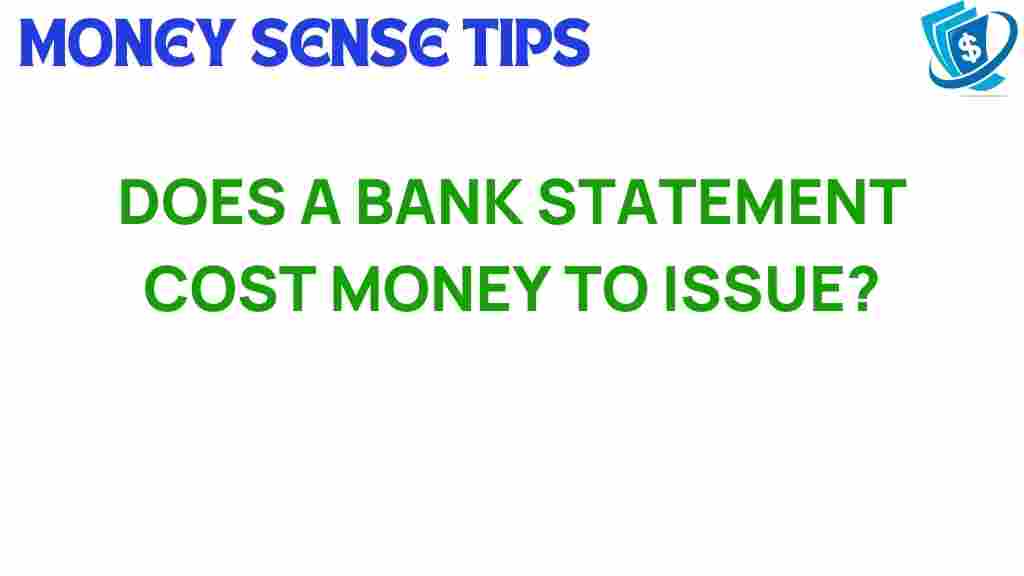Unraveling the Mystery: Do Bank Statements Come with Hidden Fees?
In today’s fast-paced financial world, understanding the intricacies of your banking costs is more crucial than ever. One key document that can provide insight into your financial health is the bank statement. However, many customers are unaware that these seemingly straightforward documents can sometimes harbor hidden fees. In this article, we will explore the potential hidden fees associated with bank statements, how to identify them, and what steps you can take to avoid unexpected charges.
What Are Bank Statements?
A bank statement is a summary of all transactions in a specific account over a given period, typically produced on a monthly basis. It includes deposits, withdrawals, transfers, and any fees charged. Understanding your bank statement is essential for effective financial management.
The Role of Bank Statements in Financial Services
Bank statements serve several purposes in financial services:
- They provide a clear record of your financial activity.
- They help you track your spending and savings goals.
- They can assist in budgeting and financial planning.
- They are often required for loan applications or other financial transactions.
Understanding Hidden Fees in Bank Statements
While reviewing your monthly statements, you might come across various service charges and account maintenance fees. These fees can sometimes be unexpected, leading to confusion regarding your banking costs. Below, we detail some common hidden fees that might be lurking in your bank statements:
- Account Maintenance Fees: Many banks charge a monthly fee for maintaining an account, which can vary widely among financial institutions.
- Overdraft Fees: If your account balance goes below zero, you may incur overdraft charges that can significantly impact your finances.
- ATM Fees: Using ATMs outside of your bank’s network can result in additional fees that may not be immediately apparent.
- Wire Transfer Fees: Sending or receiving money via wire transfer often incurs service charges that can add up quickly.
- Inactivity Fees: Some banks charge fees if an account remains inactive for a certain period, which can surprise customers.
How to Identify Hidden Fees in Your Bank Statement
Identifying hidden fees in your bank statement requires careful scrutiny. Here’s a step-by-step process to help you spot these charges:
1. Review Your Statement Regularly
Make it a habit to review your bank statements every month. Look for any unfamiliar charges or fees that you did not anticipate.
2. Understand Your Fee Structure
Visit your bank’s website or speak with a customer service representative to understand the fee structure associated with your account. This knowledge will help you recognize any unexpected charges.
3. Keep Track of Transactions
Maintain a personal record of your transactions and compare them with your bank statement. This will help you identify any discrepancies easily.
4. Look for Patterns
Identify if certain fees are incurred regularly. This can alert you to ongoing costs that may be avoidable.
5. Utilize Online Banking Tools
Many banks offer online tools that can help you monitor your account activity and alert you to potential fees. Take advantage of these tools to stay informed.
Common Troubleshooting Tips for Hidden Fees
If you discover hidden fees on your bank statement, here are some troubleshooting tips:
1. Contact Customer Service
If you notice a charge that you believe is incorrect, contact your bank’s customer service. They can provide clarification and potentially reverse erroneous fees.
2. Review Bank Policies
Familiarize yourself with your bank’s policies regarding fees. This knowledge can help you argue your case if you believe a fee was charged unfairly.
3. Consider Switching Banks
If you frequently encounter hidden fees and are dissatisfied with your current bank’s services, consider exploring other banking options. Many banks offer fee-free accounts or lower fees.
4. Set Up Alerts
Many banks allow you to set up alerts for transactions and account balances. This can help you stay informed and avoid incurring fees unknowingly.
5. Review Your Account Type
Ensure that you have the right type of account for your financial needs. Some accounts come with fewer fees, especially if you maintain a minimum balance.
Conclusion: Stay Informed to Avoid Hidden Fees
Understanding your bank statement is essential for managing your finances effectively. By taking the time to review your monthly statements, you can identify hidden fees and take proactive steps to minimize banking costs. Remember to communicate with your bank about any unexpected charges and consider alternative banking options if necessary. Staying informed and vigilant can help you maintain control over your finances and avoid unnecessary service charges.
For more on managing your finances and understanding banking costs, check out this helpful resource. If you need assistance with specific customer inquiries, don’t hesitate to reach out to your bank directly.
By unraveling the mystery of hidden fees in bank statements, you empower yourself to make informed financial decisions. Take charge of your banking experience and ensure that you are not paying more than you should!
This article is in the category Services and created by MoneySenseTips Team
